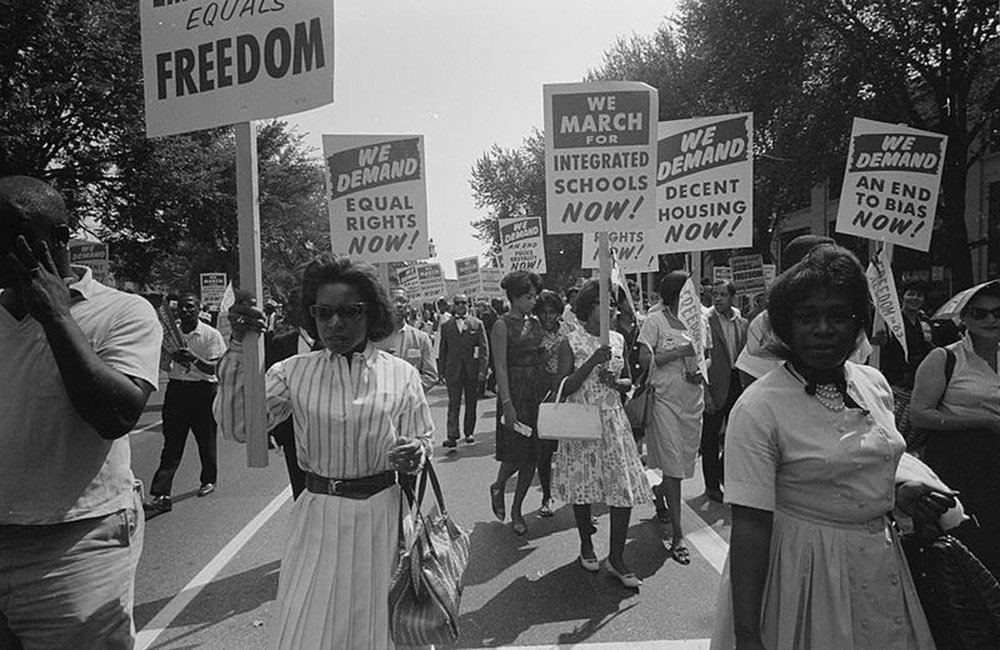These 10 Black artists and achievers have played an important role in our regional and national history.

Most likely, you learned about Martin Luther King Jr. at some point in your education. But there are other Black trailblazers, civil rights leaders and historical figures who’ve made a meaningful impact on our region – sometimes directly, sometimes indirectly through the legacy of their national work.
The contributions of the following men and women are inspiring and worth knowing about. Journey through a timeline of American history as you take in their stories.
Crispus Attucks
1723-1770
The American Revolution is a popular topic of study in America’s public schools’ curriculum, yet Crispus Attucks doesn’t come to mind as fast as Paul Revere, George Washington or Marquis de Lafayette. Allegedly a runaway slave, Attucks was the first to fall when British soldiers fired their muskets during the Boston Massacre on March 5, 1770, making Attucks the first man to die for the cause of American independence. He was buried with his fellow Boston Massacre victims and has since been regarded as a martyr in American history.
Jean Baptiste Point du Sable
1745?-1818
It’s unclear exactly when Jean Baptiste Point du Sable was born, but at some point in the 1770s, the adventurer made his way up the Mississippi River to modern-day Peoria, where he met and married a Potawatomi woman named Catherine. Soon after, DuSable established a permanent settlement and trading post along where the Chicago River meets Lake Michigan, and thus is credited as the founder of Chicago.
Dr. Rebecca Lee Crumpler
1831-1895
To put into perspective how impressive it is that Dr. Rebecca Lee Crumpler became the first Black woman physician in the United States, consider these statistics. In 1860, there were nearly 55,000 physicians in the U.S., and only 300 of them were women. And none of them were Black.
So, when Crumpler graduated from the New England Female Medical College (which some male physicians already regarded as a controversial institution) in 1864, it was a landmark achievement.
She opened a medical practice in Boston, but soon relocated to Richmond, Va., after the Civil War ended in 1865. According to her journal published in 1883, entitled “Book of Medical Discourses in Two Parts,” she wanted to conduct “real missionary work” by caring for formerly enslaved people. The book is regarded as one of the first medical publications by a Black author.
Crumpler returned to Boston in the late 1860s, where she continued to treat patients, primarily those who had limited access to medical care. Her pioneering achievements leave a legacy of persisting against adversity.
Dr. Daniel Hale Williams
1856-1931
Pursuing a career in medicine is ambitious enough, but it takes an elevated drive to develop new surgical techniques.
Dr. Daniel Hale Williams spent parts of his childhood in Janesville, Wis., where an apprenticeship with an accomplished surgeon compelled him to apply for medical school. After graduating in 1883 from Chicago Medical College, Williams opened his own medical office in Chicago, where he treated patients of all races.
Williams practiced medicine during a time when discrimination prevailed. Noticing a lack of people of color employed in the medical profession, he founded Provident Hospital – originally a 12-bed facility – that also housed the first nursing school for Black women. Provident Hospital maintained a racially diverse staff and board, and expanded into a new 65-bed building after only five years.
In 1893, Williams became the first surgeon to perform open-heart surgery on a human patient when he repaired the pericardium of a man named James Cornish, who presented at Provident Hospital with a severe stab wound. The successful procedure made Williams a pioneer in the medical field. He continued practicing medicine for many years, in many places, and in 1913 he became a charter member and the first Black physician in the American College of Surgeons.
Today, Williams is remembered for his medical accomplishments and adjacent civil rights work in the medical field.
Madam C.J. Walker
1867-1919
America loves a rags-to-riches story, and one of the best examples is that of Madam C.J. Walker. Born to parents who had been slaves, Walker grew up in poverty and was orphaned at a young age. After enduring a scalp ailment during the 1890s that resulted in the loss of her hair, she began to experiment with home remedies, which led to the creation of her own line of hair care products for Black women.
As business boomed rapidly, Walker opened a factory and beauty school in Pittsburgh, in 1908, which she soon relocated to Indianapolis. She employed thousands of Black saleswomen to promote her products and ultimately became the first self-made woman millionaire.
Not one to stay silent, Walker requested several times to speak about her success at the National Negro Business League Convention held in Chicago in 1912, but was repeatedly denied. On the final day of the convention, Walker rose from the audience, interrupted the schedule of speakers, and detailed her story anyway. Her “outburst” made an impact, and the following year, Booker T. Washington himself asked Walker to be an official speaker at the 1913 convention.
With her wealth, Walker embraced philanthropic efforts, including developing educational scholarships and donating to the NAACP, among other endeavors. She is remembered as a pioneering entrepreneur and generous philanthropist.
Alice Allison Dunnigan
1906-1983
An impressive journalism career followed the precocious childhood of Alice Allison Dunnigan. At just 13 years old, the teenager began writing for her local newspaper. After graduating from a segregated high school, Dunnigan attended what’s now known as Kentucky State University in Frankfort, Ky., and launched into a nearly 20-year teaching career that she balanced with her journalism work.
Part of Dunnigan’s freelance work involved writing for “The Chicago Defender,” which specifically served Chicago’s Black population. In 1947, she became the chief of the Chicago-based “Associated Negro Press,” which opened doors to becoming the first Black woman to follow a presidential campaign tour out on the road (in 1948 for Harry Truman) despite having to pay her own way.
The first Black woman to become a White House correspondent, Dunnigan is remembered as a hard-hitting reporter who wasn’t afraid to ask difficult questions.
Amelia Boynton Robinson
1911-2015
If you saw the 2014 film “Selma,” you’re likely familiar with civil rights activist Amelia Boynton Robinson, as she was on the front lines of the demonstrators marching from Selma, Ala., to the state’s capital of Montgomery to protest racially motivated injustice.
But even decades before those 1965 marches, Boynton Robinson was advocating for voting rights after becoming one of the first Black women registered to vote in Selma.
Once Congress passed the Civil Rights Act in 1964, Boynton Robinson was the first Black woman (and woman in general) to run for Congress in the state of Alabama. Despite not winning, she continued to persist in civil rights work, and just one year later, she worked with Martin Luther King Jr. to plan the Selma marches, using her house as headquarters. During the first march, Boynton Robinson and fellow activists were beaten by police for refusing to retreat. The event gained nationwide media attention and became known as Bloody Sunday. Despite her injuries, Boynton Robinson was present at the second and third Selma marches, which helped spurn the passage of the Voting Rights Act of 1965.
Throughout the rest of her life, Boynton Robinson remained active in promoting civil rights, and in 1990, she received the Martin Luther King Jr. Medal of Freedom.
In 2015, at age 103, she marked the 50th anniversary of the Selma marches by once again walking across the Edmund Pettus Bridge, this time joined by President Barack Obama, the late Congressman John Lewis and hundreds of others.
Gwendolyn Brooks
1917-2000
Similar to Harlem, in New York, Chicago’s South Side experienced its own creative movement during the 20th century known as the Chicago Black Renaissance. Influenced by the Great Migration, which saw tens of thousands of Black people move to Chicago from the South, the Chicago Black Renaissance encapsulates a transformative period of art and culture. Many artists, performers, writers and musicians blossomed during this period, including the poet Gwendolyn Brooks.
Brooks is regarded as one of the most influential and widely read poets of the 20th Century. Born in Kansas, Brooks migrated to Chicago with her family when she was a baby. Her first poem, “Eventide,” was published when she was just 13 years old, and by the time she was 17, her work was being published frequently in “The Chicago Defender.”
Throughout her writing career, Brooks authored more than 20 books of poetry, in addition to other works. Her subject matter often focused on the day-to-day struggles of ordinary people in her community.
Brooks earned numerous awards and honors throughout her lifetime, including being a poet laureate of the State of Illinois and a poetry consultant to the Library of Congress. On, May 1, 1950, she won a Pulitzer Prize for her work “Annie Allen,” making her the first Black person to receive the award.
Diane Nash
b. 1938
Born and raised in Chicago, Diane Nash became active in civil rights while attending Fisk University, in Nashville. Here, she witnessed severe racial segregation, which prompted her to lead student sit-in movements at discriminatory restaurants throughout the city. These peaceful protests involved hundreds of college students, and in 1960, Nashville became the first southern city to desegregate its lunch counters.
After this victory, Nash didn’t stall in her civil rights work. In 1961, she helped coordinate Freedom Rides across the South, with the aim to desegregate public transportation. Despite the violence that these peaceful protests prompted, Nash continued to organize Freedom Rides until segregated bus travel and terminals became illegal in late 1961.
Nash continued to fight for civil rights by organizing voter registration and school desegregation campaigns, enduring numerous arrests along the way. Her work helped lead to the passage of the Civil Rights Act of 1964, which prohibits discrimination in public places, and the Voting Rights Act of 1965, which prohibits racial discrimination in voting (including outlawing poll taxes, literacy tests and other restrictions that denied Black people the right to vote). Having organized some of the most successful campaigns of the civil rights movement, Nash is widely acclaimed for her activist work.
Dr. Charles Smith
b. 1940
Born in New Orleans, but raised mostly in Chicago, Dr. Charles Smith’s profound life experiences are reflected in his sculptural art. As a teenager, Smith attended the funeral of Emmet Till, which expanded his ideas about racism toward Black Americans. In 1966, he was drafted into the U.S. Marine Corps and served for two years in the Vietnam War. The experience yielded post-traumatic stress syndrome, which, combined with the pains of experiencing racism, propelled him into a years-long spiral of drug addiction and poverty.
It wasn’t until the late 1980s that Smith began to showcase his talents as an artist. Using a variety of materials, he slowly transformed his Aurora, Ill., home and yard into a monumental sculptural environment that commemorated Black history. His work chronicles both well-known and obscure people and events, from slaves migrating through the Middle Passage to Smith’s fellow soldiers dying in Vietnam. Over the years, the site came to encompass nearly 600 sculptures and 150 fixed monuments.
In the early 2000s, Smith relocated to care for his mother and gifted many of his sculptures to museums around the country, including the John Michael Kohler Arts Center in Sheboygan, Wis. Smith continues to create art from his home in Louisiana.




















































